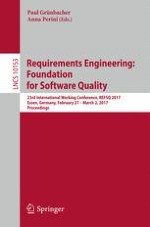2017 | OriginalPaper | Buchkapitel
Using NLP to Detect Requirements Defects: An Industrial Experience in the Railway Domain
verfasst von : Benedetta Rosadini, Alessio Ferrari, Gloria Gori, Alessandro Fantechi, Stefania Gnesi, Iacopo Trotta, Stefano Bacherini
Erschienen in: Requirements Engineering: Foundation for Software Quality
Aktivieren Sie unsere intelligente Suche, um passende Fachinhalte oder Patente zu finden.
Wählen Sie Textabschnitte aus um mit Künstlicher Intelligenz passenden Patente zu finden. powered by
Markieren Sie Textabschnitte, um KI-gestützt weitere passende Inhalte zu finden. powered by
